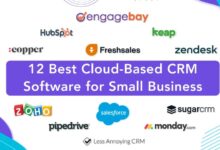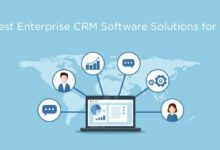CRM for Sales and Marketing Automation
CRM for Sales and Marketing Automation represents a powerful synergy, streamlining processes and boosting efficiency. This integration allows sales and marketing teams to collaborate seamlessly, leveraging data-driven insights for improved lead nurturing, targeted campaigns, and ultimately, increased revenue. Understanding the key features and benefits of a unified CRM system is crucial for businesses seeking to optimize their sales and marketing efforts in today’s competitive landscape.
This exploration delves into the core functionalities of such systems, highlighting the distinctions between sales-centric and fully integrated solutions. We’ll examine the advantages of automation, explore various deployment models, and discuss the importance of integrating the CRM with other business tools for enhanced data analysis and reporting. Ultimately, this guide aims to equip businesses with the knowledge necessary to select and implement a CRM system that aligns perfectly with their specific needs and goals.
Defining CRM for Sales and Marketing Automation
A Customer Relationship Management (CRM) system designed for sales and marketing automation streamlines processes, improves team collaboration, and ultimately drives revenue growth. It acts as a central hub for all customer interactions, providing a holistic view of each customer journey. This allows businesses to personalize engagement, optimize campaigns, and boost overall efficiency.
A CRM system, at its core, is a software application designed to manage and analyze customer interactions and data throughout the customer lifecycle. For sales and marketing, this means integrating various functionalities to manage leads, track interactions, automate tasks, and analyze campaign performance. This unified approach provides a single source of truth for both teams, eliminating data silos and improving decision-making.
Core Functionalities of a Sales and Marketing CRM
A comprehensive CRM for sales and marketing automation encompasses a broad range of functionalities. These include contact management (storing and organizing customer information), lead management (tracking potential customers from initial contact to conversion), sales pipeline management (visualizing and managing the sales process), marketing automation (automating repetitive marketing tasks like email campaigns and social media posting), campaign management (planning, executing, and analyzing marketing campaigns), reporting and analytics (tracking key metrics to measure performance), and integration with other business tools (such as email marketing platforms and social media management tools). The system’s ability to connect these functions seamlessly is key to its effectiveness.
Key Differences Between Sales-Focused and Integrated CRMs
Sales-focused CRMs primarily concentrate on managing the sales process, focusing on features like opportunity tracking, sales forecasting, and contact management specific to sales representatives. Conversely, CRMs incorporating marketing automation extend these functionalities by adding features for campaign management, lead nurturing, marketing analytics, and automation of marketing tasks. The key difference lies in the scope: sales-focused CRMs manage the sales pipeline, while integrated CRMs manage the entire customer journey from initial contact through to post-purchase engagement. This integration allows for a more holistic and efficient approach to customer relationship management.
Examples of Sales and Marketing Collaboration in a Unified CRM
Imagine a scenario where a marketing team runs a targeted email campaign promoting a new product. The CRM tracks which leads open the email, click links, and ultimately download a brochure. This information is automatically updated in the CRM, providing sales representatives with a detailed overview of each lead’s engagement level. Sales can then prioritize contacting leads who showed high engagement, increasing the likelihood of conversion. Furthermore, sales representatives can input their interactions with leads (calls, meetings, etc.), which feeds back into marketing, allowing for adjustments to future campaigns based on real-time sales data. This seamless data flow enables a more effective, data-driven approach to both sales and marketing efforts, fostering improved collaboration and overall business success. Another example would be a sales team using the CRM’s reporting features to identify high-performing products or customer segments. This information can be used by the marketing team to refine their targeting and messaging, creating more effective campaigns that resonate with specific customer groups.
Benefits of Integrated Sales and Marketing Automation
Integrating sales and marketing automation through a CRM system offers significant advantages, leading to improved efficiency, increased revenue, and a stronger return on investment. By unifying these previously disparate functions, businesses can create a more cohesive and effective customer journey.
Streamlined Lead Management through CRM systems offers several key advantages. Efficient lead management is crucial for converting prospects into paying customers.
Improved Lead Qualification and Scoring
A CRM system automates the process of lead qualification and scoring. This involves assigning values to leads based on various criteria such as demographics, engagement level, and purchase history. Leads are automatically prioritized based on their score, ensuring sales teams focus their efforts on the most promising prospects. This leads to higher conversion rates and reduced wasted effort on unqualified leads. For example, a company using a CRM might automatically flag leads who have downloaded specific white papers or visited key pages on their website as high-potential leads, allowing the sales team to immediately engage them.
Enhanced Lead Nurturing and Follow-up
Automated workflows within the CRM enable systematic lead nurturing. This involves sending targeted emails, providing valuable content, and scheduling follow-up calls based on pre-defined rules and triggers. This ensures consistent engagement with leads, building relationships and increasing the likelihood of conversion. A real-world example would be an automated email sequence sent to leads who attended a webinar, providing additional relevant resources and scheduling a follow-up call a week later.
Automated Workflows Improve Sales Team Efficiency
Automating repetitive tasks frees up sales representatives to focus on higher-value activities like building relationships and closing deals.
Reduced Administrative Overhead
CRM systems automate many administrative tasks such as data entry, reporting, and follow-up communications. This reduces the administrative burden on sales teams, allowing them to dedicate more time to selling. For instance, automatically updating customer information after a call or populating sales reports with data directly from customer interactions saves considerable time and effort.
Improved Sales Forecasting and Pipeline Management
CRMs provide real-time visibility into the sales pipeline, enabling accurate sales forecasting. This helps businesses make data-driven decisions about resource allocation and sales strategies. Sales managers can easily track progress, identify bottlenecks, and take proactive steps to improve performance. For example, if a particular stage in the sales pipeline is consistently experiencing delays, managers can investigate the root cause and implement corrective actions.
Impact of Integrated Systems on Marketing Campaign Performance and ROI
Integrating sales and marketing data provides valuable insights into campaign performance and ROI.
Data-Driven Decision Making
The combined data from sales and marketing activities provides a comprehensive view of customer behavior, allowing for more informed decision-making. This leads to more effective marketing campaigns and improved ROI. For example, analyzing data from both sales and marketing campaigns can reveal which channels are most effective at generating leads and which marketing messages resonate best with target audiences.
Improved Customer Segmentation and Targeting
Integrated systems enable more precise customer segmentation and targeting. By combining sales data with marketing data, businesses can create more detailed customer profiles, allowing them to tailor marketing messages and offers to specific segments. This results in higher engagement rates and improved conversion rates.
Cost-Effectiveness of CRM versus Manual Processes
| Feature | CRM System | Manual Processes |
|---|---|---|
| Lead Management | Automated lead scoring, qualification, and nurturing; reduced manual effort | Manual lead tracking, qualification, and follow-up; time-consuming and prone to errors |
| Sales Process | Automated workflows, task management, and reporting; improved efficiency | Manual task management, tracking, and reporting; inefficient and error-prone |
| Marketing Campaigns | Automated email marketing, campaign tracking, and analytics; improved ROI | Manual campaign management, tracking, and analysis; time-consuming and less effective |
| Data Management | Centralized data storage, improved data accuracy, and easy access; reduced errors | Dispersed data storage, potential for data inconsistencies and errors; difficult to access and analyze |
Key Features of a Robust CRM System
A robust CRM system is more than just a contact list; it’s the central nervous system of your sales and marketing efforts. Its effectiveness hinges on a powerful blend of features that streamline processes, automate tasks, and provide valuable insights into customer behavior. Choosing the right CRM means selecting one that offers the right balance of functionality to meet your specific needs.
A truly effective CRM seamlessly integrates sales and marketing automation, fostering a cohesive and efficient approach to customer relationship management. This integration allows for a more streamlined and efficient sales process, improved marketing campaign performance, and a deeper understanding of customer behavior. This leads to increased revenue and improved customer satisfaction.
Essential Sales Automation Features within a CRM
Sales automation within a CRM aims to free up sales representatives’ time, allowing them to focus on higher-value activities like closing deals and building relationships. Key features contributing to this include:
- Lead Management: This includes tools for capturing, qualifying, and nurturing leads, assigning them to appropriate sales representatives, and tracking their progress through the sales pipeline. Features such as lead scoring and automated email sequences are crucial.
- Contact Management: A centralized database of customer and prospect information, accessible to all relevant team members, ensuring consistency and preventing data silos. This includes comprehensive contact details, interaction history, and notes from previous communications.
- Sales Pipeline Management: Visual representations of the sales process, allowing sales teams to track deals at each stage, identify bottlenecks, and forecast revenue accurately. This often involves customizable pipeline stages and reporting capabilities.
- Sales Forecasting: Predictive analytics based on historical data and current pipeline activity, enabling sales managers to make informed decisions regarding resource allocation and sales targets. This helps in anticipating future revenue and adjusting strategies accordingly.
- Reporting and Analytics: Detailed reports on sales performance, conversion rates, and other key metrics, providing valuable insights into areas for improvement. Customizable dashboards allow for quick access to relevant data.
Critical Components for Effective Marketing Automation within a CRM
Marketing automation within a CRM focuses on streamlining marketing efforts, personalizing customer interactions, and optimizing campaign performance. Essential components include:
- Email Marketing: Automated email sequences triggered by specific actions (e.g., website visit, form submission), personalized email content based on customer segmentation and behavior, and email performance tracking.
- Marketing Campaign Management: Tools for planning, executing, and analyzing marketing campaigns across various channels (email, social media, etc.), providing a centralized view of campaign performance and ROI.
- Customer Segmentation: The ability to segment customers based on demographics, behavior, and other criteria, allowing for targeted marketing messages and personalized experiences. This enhances the effectiveness of marketing efforts.
- Social Media Integration: Connecting CRM data with social media platforms to monitor brand mentions, engage with customers, and track social media campaign performance.
- Lead Scoring and Nurturing: Assigning scores to leads based on their engagement and other factors, allowing sales teams to prioritize high-potential leads and nurture less-qualified leads through targeted marketing efforts. This helps convert leads into customers more efficiently.
Workflow of a Lead Through a Sales and Marketing Automated CRM
The following flowchart illustrates a typical lead journey through a sales and marketing automated CRM:
A simplified representation: Website Visit → Lead Capture Form → Lead Scoring & Segmentation → Automated Email Sequence (Nurturing) → Sales Qualification → Sales Engagement → Deal Closing → Customer Relationship Management.
Choosing the Right CRM System
Selecting the appropriate CRM system is crucial for maximizing its benefits. The wrong choice can lead to wasted resources and a lack of integration, hindering rather than helping your sales and marketing efforts. A careful evaluation of your business needs and available options is paramount.
Choosing the right CRM involves understanding your business requirements and matching them with the capabilities of different systems. This process requires consideration of various factors, including deployment model, features, scalability, and cost.
CRM Deployment Models: Cloud-Based vs. On-Premise
Cloud-based and on-premise deployments represent distinct approaches to CRM implementation. Cloud-based CRMs, also known as Software as a Service (SaaS), are hosted on the vendor’s servers and accessed via the internet. On-premise CRMs, conversely, are installed and maintained on the company’s own servers.
- Cloud-Based CRM: Offers advantages such as accessibility from anywhere with an internet connection, automatic updates, lower upfront costs, and scalability. However, reliance on internet connectivity and potential security concerns related to data storage on third-party servers are factors to consider.
- On-Premise CRM: Provides greater control over data security and customization options. However, it requires significant upfront investment in hardware and software, ongoing maintenance, and dedicated IT personnel. Scalability can also be more challenging and costly.
Factors to Consider When Selecting a CRM
Several key factors influence the selection of a CRM system, significantly impacted by business size and industry. These factors should be carefully weighed against each other to arrive at the optimal solution.
- Business Size: Small businesses often prioritize ease of use, affordability, and basic functionality. Larger enterprises may require more sophisticated features, scalability, and robust integration capabilities.
- Industry: Specific industry requirements dictate the features needed. For example, a CRM for a healthcare provider will have different needs than one for a retail company (e.g., HIPAA compliance vs. inventory management integration).
- Budget: CRM systems range widely in price, from affordable options for startups to enterprise-level solutions with substantial costs. It’s crucial to align the budget with the desired features and scalability.
- Integration Capabilities: The CRM should seamlessly integrate with existing business systems, such as email marketing platforms, accounting software, and e-commerce platforms.
- Scalability: The chosen CRM should be able to adapt to the company’s growth, handling increasing data volumes and user numbers without performance degradation.
- User-Friendliness: A user-friendly interface is critical for adoption and maximizing the system’s value. Complex systems can lead to low user engagement and ultimately, failure.
Examples of CRM Systems for Different Business Sizes
The choice of CRM is heavily influenced by the size and needs of the business.
- Small Businesses: Examples include HubSpot CRM (free plan available), Zoho CRM, and Pipedrive. These platforms generally offer intuitive interfaces, affordable pricing, and essential features for managing contacts, leads, and sales processes.
- Large Enterprises: Salesforce, Microsoft Dynamics 365, and Oracle Siebel are examples of enterprise-level CRMs. These platforms provide advanced functionalities, robust scalability, extensive customization options, and sophisticated reporting and analytics capabilities. They often require dedicated IT support and significant financial investment.
Integration with Other Business Tools
A truly effective CRM system isn’t a standalone entity; its power is amplified significantly through seamless integration with other business tools. Connecting your CRM to your marketing automation platform, email marketing service, social media management tools, and other relevant applications creates a unified view of your customer interactions, streamlining workflows and improving overall efficiency. This integration avoids data silos and ensures consistent messaging across all customer touchpoints.
Integrating your CRM with other tools enhances your ability to gather comprehensive data, analyze customer behavior, and ultimately, make more informed business decisions. The interconnectedness of these systems allows for a more holistic understanding of the customer journey, from initial contact to post-purchase engagement. This integrated data flow fuels more precise segmentation for marketing campaigns, leading to higher conversion rates and improved ROI.
Data Integration and Enhanced Reporting
The combination of data from various integrated systems dramatically improves reporting and analysis capabilities. For example, integrating your CRM with a marketing automation platform provides a complete picture of campaign performance, showing not only email open rates and click-through rates but also the subsequent actions taken by customers within the CRM, such as sales calls or purchases. This level of detail allows for precise measurement of marketing ROI and identification of high-performing campaigns and underperforming areas. Furthermore, integrating sales data with marketing data reveals which marketing channels are most effective in generating qualified leads and ultimately, driving revenue. This comprehensive data visualization facilitates better strategic decision-making and resource allocation.
Data Privacy and Security in Integrated Systems
Managing data privacy and security is paramount when integrating multiple systems. Choosing CRM and other software providers who adhere to stringent data protection regulations, such as GDPR and CCPA, is crucial. Implementing robust security measures, including encryption both in transit and at rest, access controls, and regular security audits, is essential to protect sensitive customer data. Data anonymization and pseudonymization techniques can further mitigate privacy risks. Regularly reviewing and updating security protocols and employee training on data protection best practices are vital ongoing steps in maintaining data integrity and compliance. Furthermore, a clear data governance policy defining data ownership, access rights, and data retention policies is essential for responsible data management across all integrated systems.
Measuring Success and ROI
Implementing a CRM for sales and marketing automation is a significant investment. Understanding how to measure its effectiveness and demonstrate a clear return on investment (ROI) is crucial for justifying the initial expenditure and securing ongoing support. This involves tracking key performance indicators (KPIs) and analyzing the data to identify areas for improvement and optimization.
Successful CRM implementation isn’t just about using the software; it’s about leveraging its capabilities to drive tangible business results. By meticulously tracking relevant metrics and analyzing trends, businesses can fine-tune their strategies, improve efficiency, and ultimately maximize their return on investment. This section will outline key performance indicators, demonstrate a sample report, and explore strategies for optimizing CRM performance.
Key Performance Indicators (KPIs) for CRM Success
A range of KPIs can be used to assess the effectiveness of a CRM system. The selection will depend on specific business goals and the nature of sales and marketing activities. However, some common and impactful metrics include lead generation, conversion rates, sales cycle length, customer lifetime value, and marketing campaign ROI.
Sample Report: Tracking and Analyzing Key Metrics
Let’s consider a fictional company, “Acme Corp,” which implemented a CRM system. The following table showcases a sample report tracking key metrics over a three-month period. Note that these are illustrative figures and would vary significantly based on industry, business size, and specific CRM implementation.
| Metric | Month 1 | Month 2 | Month 3 |
|---|---|---|---|
| Leads Generated | 500 | 600 | 750 |
| Conversion Rate (Leads to Opportunities) | 20% | 25% | 30% |
| Sales Cycle Length (Days) | 45 | 40 | 35 |
| Average Deal Size ($) | 5,000 | 5,500 | 6,000 |
| Customer Acquisition Cost (CAC) ($) | 100 | 90 | 80 |
| Customer Lifetime Value (CLTV) ($) | 10,000 | 10,500 | 11,000 |
| Marketing ROI (%) | 150% | 200% | 250% |
This sample report allows Acme Corp to track progress, identify trends, and make data-driven decisions to improve their sales and marketing processes. For example, the decreasing sales cycle length suggests improvements in sales efficiency. The increasing Marketing ROI indicates effective campaign optimization.
Strategies for Optimizing CRM Performance
Maximizing ROI requires ongoing optimization. Strategies include:
Data Quality Management: Ensuring data accuracy and completeness is paramount. Regular data cleansing and validation are essential. This might involve implementing data entry rules, using data deduplication tools, and establishing processes for data verification.
User Adoption and Training: Effective CRM usage relies on proper training and ongoing support for users. Regular training sessions and readily available resources can significantly improve adoption rates and data quality.
Process Optimization: Analyze sales and marketing workflows to identify bottlenecks and inefficiencies. Streamlining processes within the CRM system can shorten sales cycles and improve overall efficiency. This might involve automating repetitive tasks or optimizing lead routing and assignment.
Reporting and Analytics: Regularly review key performance indicators and analyze trends to identify areas for improvement. Use data-driven insights to adjust strategies and optimize campaigns for better results. This could include A/B testing different marketing approaches or refining sales strategies based on conversion rates.
Integration with other systems: Seamless integration with other business tools such as marketing automation platforms, e-commerce systems, and accounting software can enhance data flow and improve overall efficiency.
Case Studies and Best Practices
Successful CRM implementation hinges on more than just choosing the right software; it requires a strategic approach encompassing data management, user training, and a well-defined implementation plan. Understanding best practices and learning from real-world examples significantly increases the likelihood of achieving a positive ROI.
Successful CRM Implementations Across Industries
Several companies across diverse sectors have demonstrated the transformative power of CRM. For example, a large e-commerce company significantly improved customer retention rates by leveraging a CRM system to personalize marketing campaigns and provide proactive customer service. Detailed customer interaction histories allowed them to anticipate needs and address concerns swiftly, resulting in a measurable increase in customer loyalty. In the financial services industry, a leading bank streamlined its onboarding process and reduced operational costs by automating client data entry and communication workflows within their CRM. This resulted in faster account setup and improved customer satisfaction scores. Finally, a manufacturing company used its CRM to track lead generation, sales progress, and customer service interactions, resulting in better sales forecasting and improved inventory management. These examples illustrate the versatility of CRM and its adaptability to various business models.
Data Management Best Practices within a CRM Environment
Effective data management is crucial for maximizing the benefits of a CRM system. This involves establishing clear data governance policies, ensuring data accuracy and consistency, and implementing regular data cleansing processes. A well-defined data structure, with clear field definitions and data validation rules, prevents inconsistencies and improves data quality. Regular data backups and disaster recovery plans are also essential to safeguard valuable customer information. Furthermore, access control mechanisms should be implemented to restrict access to sensitive data based on user roles and responsibilities. Finally, utilizing data analytics tools within the CRM to identify trends and patterns can inform strategic decision-making and optimize business processes.
User Training and Adoption Strategies
Successful CRM adoption requires comprehensive user training. This should involve a combination of instructor-led training, online tutorials, and ongoing support. Training should cover all aspects of the CRM system, from basic navigation and data entry to advanced features such as reporting and analytics. Providing users with real-world scenarios and practical exercises enhances their understanding and improves knowledge retention. Furthermore, establishing a system of ongoing support, including FAQs, help desk access, and regular training updates, ensures users can effectively utilize the CRM system over time. Regular feedback sessions and user surveys can identify areas for improvement in training and system usability, ultimately leading to higher user adoption rates.
Step-by-Step Guide to Effective CRM Implementation
Implementing a CRM system effectively requires a phased approach. First, conduct a thorough needs assessment to identify the specific business requirements and objectives. This involves analyzing existing processes, identifying pain points, and defining key performance indicators (KPIs). Next, select a CRM system that aligns with these requirements and integrates seamlessly with existing business tools. The third step involves data migration from legacy systems, ensuring data accuracy and consistency. Following this, user training should be conducted to ensure all users are proficient in using the new system. Finally, ongoing monitoring and optimization are crucial to ensure the CRM system continues to meet the evolving needs of the business. Regularly reviewing KPIs and making adjustments to processes as needed are essential for maximizing the return on investment.
Last Word
Implementing a CRM for Sales and Marketing Automation offers significant advantages, transforming how businesses manage leads, nurture prospects, and track campaign performance. By carefully selecting a system that aligns with specific business needs and integrating it effectively with other tools, companies can unlock substantial improvements in efficiency, collaboration, and ultimately, return on investment. The journey to optimized sales and marketing hinges on understanding the capabilities of integrated CRM systems and leveraging them strategically.





